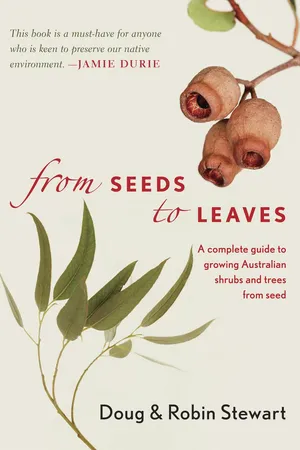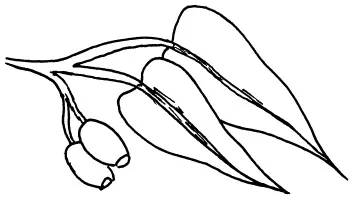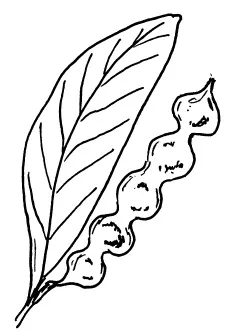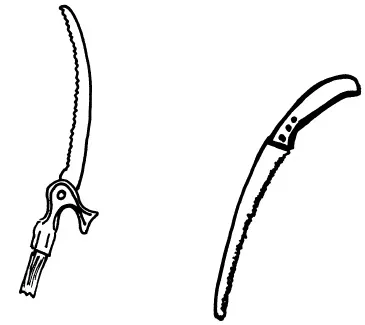
eBook - ePub
From Seeds to Leaves
A Complete Guide to Growing Australian Shrubs and Trees from Seed
This is a test
- 176 pages
- English
- ePUB (mobile friendly)
- Available on iOS & Android
eBook - ePub
Book details
Book preview
Table of contents
Citations
About This Book
If you have an interest in the power of seeds to transform the earth, or in planting Australian native trees and shrubs on a small scale or large, From Seeds to Leaves is the book for you. It describes how to:
- Collect your own fruit and nuts.
- Extract, store and germinate the seeds in the right way and in the best season.
- Use smoke to germinate seed normally difficult to grow.
- Plant out, water, mulch, protect, fertilise and prune your plants for best results.
-
As well, there are sections on botanical names and identifying plants by flower and seed, and an ABC of information about Australian species. Procedures are set out in easy table form and there are lists of plants for a variety of special purposes.'This book is a must-have for anyone who is keen to preserve our native environment.'— Jamie DurieRobin Stewart is the author of the best-selling titles Chemical Free Home; Chemical Free Pest Control; Australian Green Home & Garden; Tread Lightly and From Seeds to Leaves. She is a former sufferer of chemical sensitivity whose writing has grown out of her mission to eliminate harmful chemicals from her life
Frequently asked questions
At the moment all of our mobile-responsive ePub books are available to download via the app. Most of our PDFs are also available to download and we're working on making the final remaining ones downloadable now. Learn more here.
Both plans give you full access to the library and all of Perlego’s features. The only differences are the price and subscription period: With the annual plan you’ll save around 30% compared to 12 months on the monthly plan.
We are an online textbook subscription service, where you can get access to an entire online library for less than the price of a single book per month. With over 1 million books across 1000+ topics, we’ve got you covered! Learn more here.
Look out for the read-aloud symbol on your next book to see if you can listen to it. The read-aloud tool reads text aloud for you, highlighting the text as it is being read. You can pause it, speed it up and slow it down. Learn more here.
Yes, you can access From Seeds to Leaves by Robin Stewart in PDF and/or ePUB format, as well as other popular books in Biological Sciences & Horticulture. We have over one million books available in our catalogue for you to explore.
Information
Chapter 1
Seed collection
Seed from gardens
Once you begin to collect seed you will look at every Australian tree and shrub in a new light. Your eyes will scan each plant, searching for seed cases – and your mind will be propagating the seed and choosing a place in your garden for the beauty you see before you.
Banksias and dryandras are perhaps the most striking of our native plants, along with the Sturt desert pea. These can be grown from seed and you can collect the cases yourself from the gardens of other enthusiasts.
You will find that you discover botanical treasures in the most amazing places, so always keep secateurs, a few paper bags and a pen in your car.
Seed from bushland
Seed collection is a rewarding pastime, a hobby that is interesting and inexpensive, one that can involve a group of friends or the whole family.
Your time will be spent in pleasant natural surroundings doing something really satisfying – and as a bonus, seed collection should be carried out in fine weather!
12
In order to find suitable donor trees, plan as follows:
- Establish why you are collecting seed. Is it for your garden, a farm shelterbelt, a wildlife corridor, or perhaps for erosion control?
- Is the ground to be planted wet or dry, flat or hilly? What is the soil type?
- Find an area of natural vegetation in a similar locality. Look at the trees and shrubs and decide which you would like to propagate. Remember that local plants will suit local soil and climatic conditions, will require less water and maintenance and will blend with the surroundings and provide invaluable habitat for local wildlife.
- Learn to read seasonal signs, to recognise the cycle of flowering through to the ripeness and availability of seed. You will need to visit the area regularly to check individual species; however, most seed will be collected from early spring through to late summer.
- Identify the species during flowering and mark those trees or shrubs that seem most vigorous and healthy. Heavy flowering usually indicates high yield of seed, and the best specimens nearly always produce the more robust seedlings; so choose your trees carefully.
- Trees in park-like settings usually branch out lower to the ground. These trees will be easier to collect from than forest trees.
- Select an area where there are a number of the same species, and plan to take seed from as many healthy plants as possible.
- Watch your trees carefully as the seed cases mature. Green seed pods or follicles are usually too immature to pick, so wait until they turn brown to black-brown in colour; but hot, dry, windy weather will cause some species (especially the acacias and grevilleas) to drop their seed suddenly, so you will need to watch these plants more 13 closely.
- Acacias, banksias, callistemons, calothamnus, allocasuarinas, casuarinas, eucalypts, hakeas, melaleucas and teatrees are among the many Australian natives that grow very easily from seed, so set your sights wide!

Typical Eucalyptus with fruit

Hickory wattle
14
Do you need permission?
Certain species are protected under each State’s Flora and Fauna Guarantee Act. Seeds from these species cannot be taken from any public land without a permit; however, they can be collected from private land, with the permission of the owner.
Quarantine restrictions apply to certain plant material being transported between States.
How much, when, and from where?
Once the seed cases are ripe, choose a fine, dry day for your outing. Not only will this be more pleasant for you, but it will also ensure that the seed cases are dry, consequently reducing fungal problems.
Collect from several parts of the same tree, but concentrate on the middle and upper branches if possible, as the seed cases from here will usually be better quality than those lower down. Avoid damage to the tree or shrub.
Do not overcollect: take no more than ten per cent of seed, so that you leave sufficient for the tree itself and for all the insects, birds and animals dependent on the seed supply as food.
Methods and equipment
Seed is normally collected by hand. This can be great fun, especially in the company of good friends. It is best to work in pairs or groups, both for pleasure and safety, especially if you are planning to use ladders or vehicles.
15
You will need secateurs, labels, and cloth or paper bags. You may also need long-handled tools, for example a long-handled pruning saw.

Long handled saws.
16
Seed from fallen trees and branches
No tree should be cut down specifically for seed; however, if a tree has to be cut down anyway, you may as well harvest the seed. Likewise, if a branch or tree is damaged during a storm, the opportunity should be taken to collect the seed.
Seed that drops naturally
Most pods, berries and fleshy fruit fall when ripe and can be collected by placing beneath the tree, a sheet of plastic or a tarpaulin, weighed down with stones. You may choose to leave the sheeting down for several days, in order to collect the maximum amount.
Either an upside-down umbrella or a large cardboard box makes a good catching receptacle, especially when you give the branches a good shake. Acacias yield well when caught at the optimum time, with pods coming away easily to a light stripping action of the hands. A rake or a stick can be used to lightly beat the higher branches.
Pea-like pods
Acacias, albizias, cassias, hardenbergias, kennedias and other pea-like plants produce pods that split open along two edges when ripe. Hot, windy weather dries and matures the seed, with the pods changing colour from green to brown very rapidly. The pods may even burst open with explosive force.
17
Your aim should be to collect the seed as the pods begin to dry and split. This will ensure that the seed you collect is mature and long-lasting.
You may also find it worthwhile to pick up seed from the leaf litter beneath the tree, especially if your timing is a bit late. The seed will be hard and shiny black to brown.
Most seed of this type matures from early to late December; however, seasons can vary and so do different localities. A broad range is from mid-spring to late summer.
Fleshy berries
Fleshy berries are found on many plants, including Acmena (syn. Eugenia) smithii (lilly-pilly), Astroloma humifusum (cranberry heath) and Eremophila maculata (spotted emu bush).
Pittosporums and rainforest fruit
This fleshy fruit falls naturally to the ground, where it is often picked up and eaten by birds or animals. The seed can pass through the animal quite safely, then go on to germinate and grow some distance from the parent plant.
The berries can be gathered from beneath the plant, hand-picked or knocked off with a stick or rake onto a tarpaulin. Each berry will contain one or more seeds embedded in fleshy material, covered and sealed by the skin. Some open to release the seed, but most do not.
18
Fleshy fruit with a hard stone
Fleshy fruit (similar in type to apricots and peaches) is produced by native plants such as Macadamia integrifolia, (smooth-shelled macadamia nut) Macadamia tetraphylla (rough-shelled macadamia nut), Elaeocarpus grandis (blue quandong), Santalum lanceolatum (plum-bush or northern sandalwood), Ceratopetalum gummiferum (New South Wales Christmas bush) and Coprosma hirtella (currant bush).
These hard-stoned fruits fall to the ground when mature, so they can be gathered from beneath the tree, hand-picked, or knocked down with a stick or rake onto a tarpaulin.
Seed best trapped in a bag
Grevillea, Boronia, Correa and Pittosporum species and Nuytsia floribunda (Western Australian Christmas tree) all collect well into a fine pantyhose leg, or a bag of gauze or tough paper (plastic will sweat). Simply place the pantyhose or bag over the ripening fruit and tie firmly around the stem. Remove the bag from the plant when the fruit has matured and shed its seed into the bag. This method ensures that the seed, which tends to be released explosively on ripening, is safely collected.
Grevilleas produce small, light woody pods that ripen rapidly. As the pods burst open, seed is scattered all round the plant. Most ripen from late November to January and expel one or two seeds per pod. Grevillea pods may be picked before they fully mature and will ripen successfully if stored in a paper bag in a warm, dry place.
Boronia seed may also be collected from beneath the plant if the weather is fine and still. Spread sheeting on the ground and hold it in place with stones. The seed will fall naturally when mature.
19
Seed collected by cutting off mature flower heads
Seed of some native genera can be collected by simply cutting off the fully mature flower head and placing it in a paper bag. These include Dryandra, Isopogon (cone bush), Hibiscus, Telopea (waratah), Patersonia (native iris), Anigozanthos (kangaroo paw) Blandfordia (Christmas bells) and many genera of the family Asteraceae (daisies).
Daisies need special care to ensure good quality seed free of caterpillar damage and fungal disease. Do not collect during wet weather or after rain, check each flower head for any evidence of caterpillars, and keep the seed quite dry. Cut the flower head from the plant when the centre of the flower becomes loose.
Native iris, kangaroo paw, Christmas bells and hibiscus have capsules that split open when mature. Cut the flower heads carefully and avoid bumping the seed. In nature, seed dispersal is usually triggered by a strong gust of wind.
Each flower head of Telopea speciosissima (New South Wales waratah) produces only a few follicles, but each contains many seeds. Collect between the end of March and June in cooler districts, picking those pods that are beginning to turn brown.
Seed collection from hard woody cases
Banksia and hakea seeds are contained in very hard woody follicl...
Table of contents
- Cover Page
- Title Page
- Copyright Page
- Preface
- Introduction: The Challenge of Climate Change
- Chapter 1 Seed Collection
- Chapter 2 Extracting the Seed
- Chapter 3 Seed Needing Special Treatment before Sowing
- Chapter 4 Planting the Seed
- Chapter 5 Transplanting and Growing On
- Chapter 6 Planting Out
- Chapter 7 Botanical and Common Names Made Easy
- Chapter 8 Trees and Shrubs for Special Situations
- Chapter 9 Identification by Flower and Seed
- Chapter 10 Seed for Purpose: An Overview
- Appendix An ABC of Australian Plants and Seeds
- Index
- Acknowledgements
- About the Authors